
Zhou Qingjie
Long River Press
San Francisco
Copyright c 2010 Qingjie Zhou. All rights reserved
Published in the United States of America by
Long River Press
360 Swift Avenue, Suite 48
South San Francisco, CA 94080
www.longriverpress.com
Published in Association with Foreign Languages Press, Beijing. No part of this book may be reproduced without written permission of the publisher.
10 9 8 7 6 5 4 3 2 1
Library of Congress Cataloging-in-Publication Data
Zhou, Qingjie.
Qigong: 10 minute primer / Qingjie Zhou.
p. cm.
ISBN 978-1-59265-132-0
1. Qi gong. I. Title.
GV505.Z56 2010
613.7'148--dc22
2009036743
PRONUNCIATION GUIDE
 qpronounced chee or chi
qpronounced chee or chi
 gngpronounced gung or kung
gngpronounced gung or kung
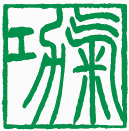
 | Contents |  |
T he concept of Qi (sometimes spelled as Chi) in Chinese medicine refers to the vital energy, or ether, that enables all organs in the human body to function normally.
More than 2,200 years ago, the Huangdi Neijing, or Yellow Emperors Classic of Internal Medicine, Chinas first comprehensive medical reference, included an elaborately detailed description of the function and purpose of Qi. It said that Qi is the chief source of all energy within the human body, and used Qi as the common factor to understand and explain the bodys physiological phenomena, the human spirit and consciousness, pathological changes, clinical diagnosis, and forms of treatment using acupuncture or other traditional medicine. It also gave names to more than 80 kinds of Qi according to their different locations and functions, and made an extensive study of the important role of Qi in the body. The concept of Gong refers to skill and the attainment of skills. The gong in Qigong means a complete dedication to the attainment of a set goal.
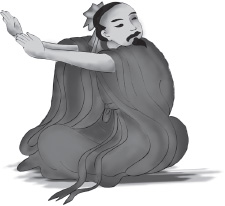
Illustrations of Physical and Breathing Exercises, each designed specifically for one of the traditional 24 Seasonal Divisions: Qigong exercise for the Beginning of Winter (around November 7 or 8)
I n ancient China, Qigong was also called tu na (adjustment of breathing), dao yin (physical and breathing exercise), zuo chan (sitting in meditation) or nei gong (internal exercise). Qigong is defined as the skill of physical and mental training which integrates the functions of the body, breathing and the mind. The benefits of Qigong are many and varied. The Qigong practitioner trains his mind, vital energy, and body in order to keep fit and prevent illness. The objective of practicing Qigong is to adjust the yin and yang balance in the body and to develop the potential ability to attain a very deep meditative state.
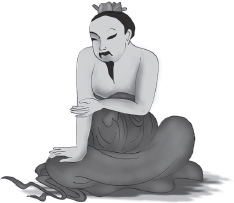
Sitting posture exercise for Lesser Snow (a seasonal division point, around November 22 or 23)

Make sure that qi is not interpreted solely as breathing and Qigong is not understood simply as a breathing exercise. Qigong includes breathing exercises, but they are not the only or main objective.
I n July 1999, U.S. President Bill Clinton sent a letter of congratulations to a world Qigong conference held in San Francisco. The conference was attended by more than 500 scholars and masters from 16 countries engaged in Qigong therapy and research. The letter stated the important influence of Qigong, an ancient form of healing, which has captured the attention of millions of people around the world. This traditional Chinese exercise is a good alternative way to maintain a healthy lifestyle which can contribute to peoples overall physical fitness.
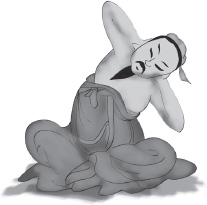
Exercise for Autumn Equinox (around September 22, 23 or 24)
The origin of Qigong
Q igong originated from primitive mans efforts to protect his health. Many of us have had the same experience: When we feel tired, we yawn, stretch, or sit with our eyes closed. After a few moments, were relaxed and more energized. It was exactly such conscious or unconscious behavior that led to the formation of Qigong as a means of fitness. Man first unconsciously and then consciously used Qigong to keep fit and to prevent and treat illness. This was the origin of Qigong.
Qigong in ancient China
A ncient burial sites dating from approximately 5,000 years ago were excavated by archaeologists in Qinghai Province in 1957. Among the relics unearthed was a colored ceramic basin painted with a lifelike dancing figure whose movements corresponded to ancient Qigong.
A jade inscription now kept in a Tianjin museum is the earliest and most significantly complete article describing Qigong ever found. Historians have dated it back to the end of the fifth century or the beginning of the fourth century B.C., during the era of the Warring States period. The inscription states: In a cycle of breathing, a deep breath allows more air to be inhaled into the lungs. Expand the breath until it can go no deeper. When the air is exhaled, it is like the budding of the grass and trees, which continue to grow. Its exit route is opposite that of its intake, and it exits completely. When breathing, inhalation is like a heavenly secret, moving upward; exhalation is more of an earthly secret, moving down. One lives if he follows this truth, or dies if he acts against it.
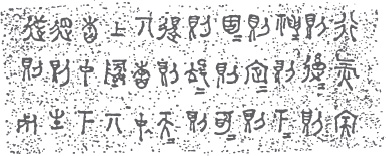
A jade inscription of the Warring States Period
The dao yin diagram of physical and breathing exercise was a burial article unearthed from the No. 3 Tomb of the Han Dynasty at Mawangdui, Changsha, in December 1973. Buried in 168 B.C., the colored diagram is painted on a piece of silk, showing men and women doing various Qigong exercises. The diagram reflected the popularity of Qigong at that time, and is therefore a highly treasured antiquity.
In the painting, more than 40 men and women are depicted performing dao yin movements. They wear informal dress, and some mens torsos and feet are bare. They stand in four lines, with 11 people in each. Each is shown doing his or her individual exercises. Brief explanations of the exercises are given. The movements and postures exhibited by these figures are divided into three categories: breathing exercises, limb exercises, and exercises with weapons.
Next page

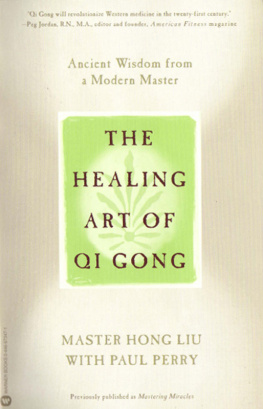
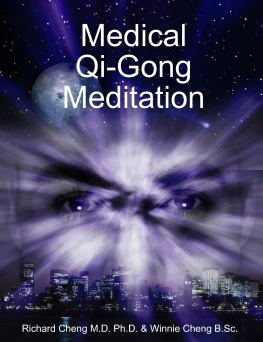


 qpronounced chee or chi
qpronounced chee or chi gngpronounced gung or kung
gngpronounced gung or kung






